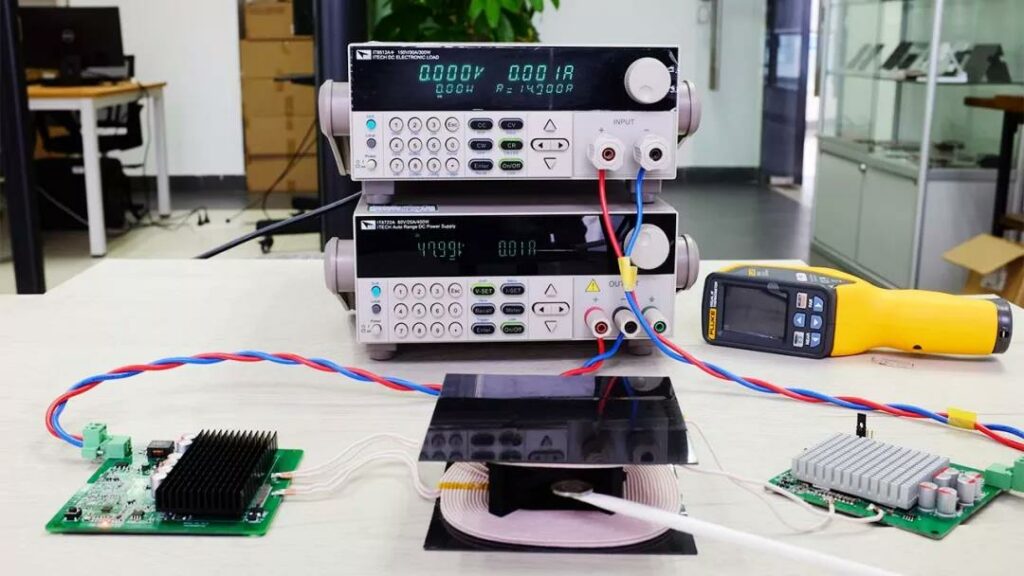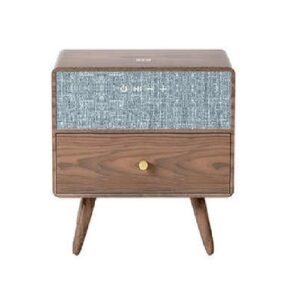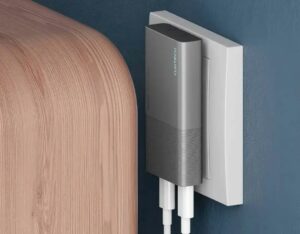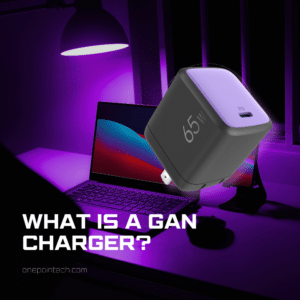Now wireless charging is a very popular technology. Besides the growing use of wireless charging in low-power consumer electronics, the demand for medium-power applications has also been on the rise. For medium-power wireless charging, electric bicycles, inspection AGVs, and mobile robots are among the most promising markets.
As a leader in the wireless charging industry, ONE POINTECH has been concentrating on the research and development, and industrialization of cutting-edge technologies in the wireless charging field and has launched wireless charging solutions ranging from a few watts to one kilowatt. Since the launch of the 50mm ultra-long-distance wireless charging solution for mobile phones in 2020, we have never stopped exploring the application of various power ranges in different markets. A few days ago, ONE POINTECH officially released the wireless charging module TE03 for the 200W mid-power market.
The ONE POINTECH 200W wireless charging module consists of two parts: the transmitter Tx (left) and the receiver Rx (right).
Both use green PCB and are equipped with north and south bridge heat sinks respectively.
In terms of size, the transmitter PCB is 100*100*18mm in length, width and height, and the coil is 120*120*8mm; the receiver PCB is 90*90*18mm in length, width and height, and the receiving coil is 120*120*5.5mm. The transmitter uses 48V6A input, the receiver fixed 54.2V output, the current can match 2A/3A/4A, and the maximum power can reach 200W.
The two PCB power supply interfaces of this solution support customization and support various protection functions such as FOD, OCP, OVP, and OTP. The charging distance is 15-35mm, and the efficiency is as high as 91% (25mm).
200W Industrial Wireless Charging Solution – Charging Efficiency Test
Under the ambient temperature of 24.8°C, the ITECH IT6722A DC power supply is used for power supply, and the ITECH IT8512A is used as the electronic load.
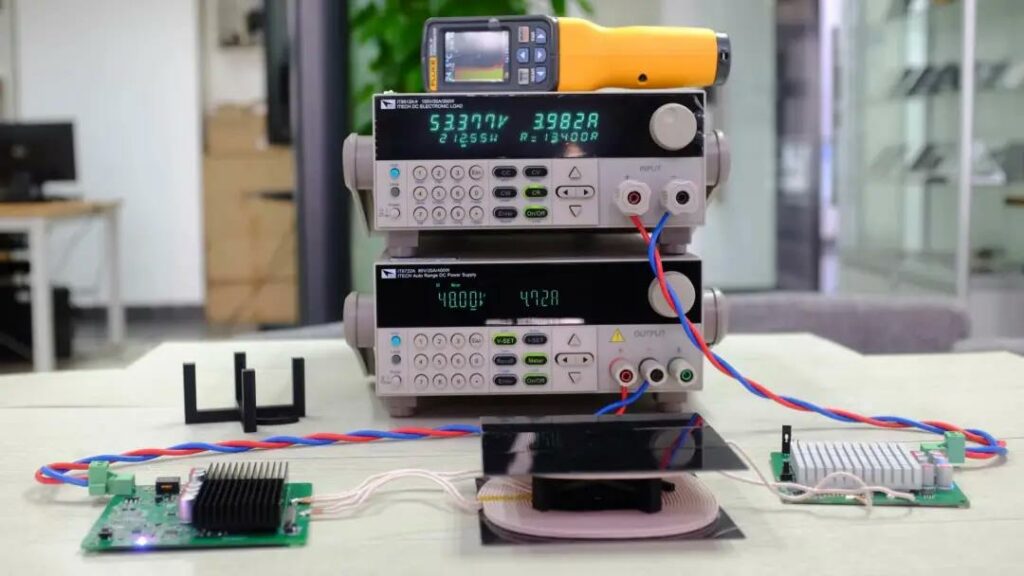
The above picture shows the scene when the transmitter coil and receiver coil are separated by 20mm and output at 4A current. It can be seen from the test data that the DC power supply voltage is 48V, the current is 4.72A, the electronic load voltage is 53.377V, and the current is 3.982A. The efficiency reached 93%.
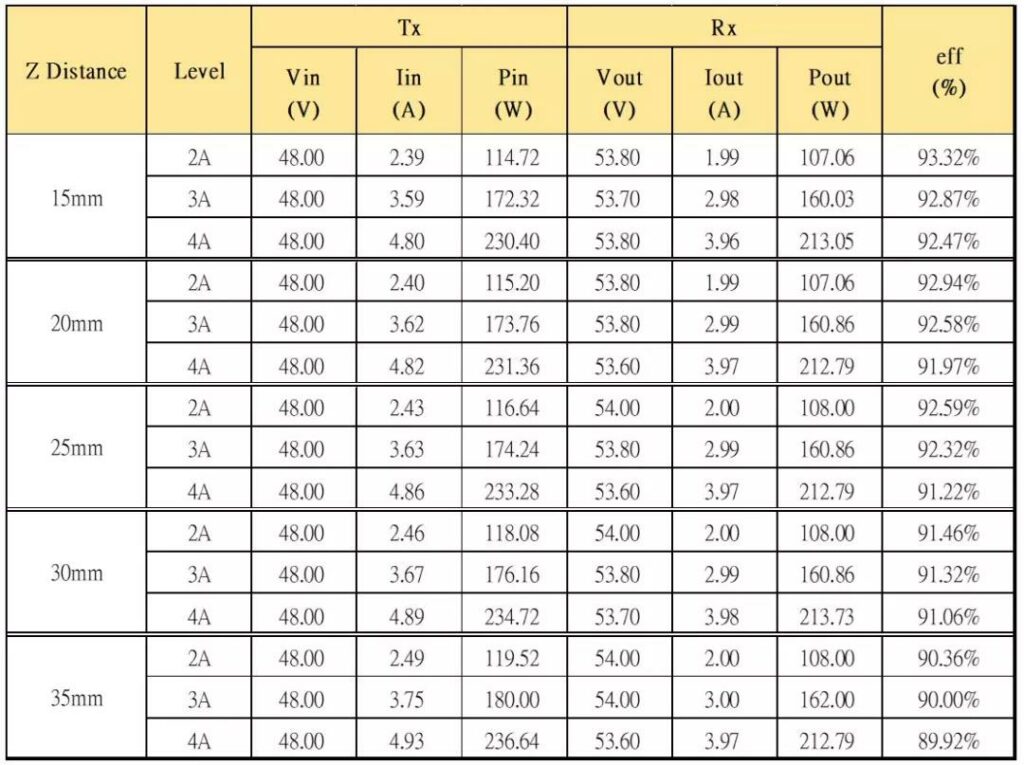
The above picture shows the efficiency data of the module at different charging distances and different output currents. When the charging distance is 15mm-20mm, the system efficiency can reach about 92%, and when the distance is 25mm-30mm, the efficiency is above 91%. , even if the coils are separated by 35mm, the system efficiency can reach about 90%.
Transmission efficiency in wireless charging is one of the parameters to determine whether its characteristics are good or not. From the above test data, the transmission efficiency can reach more than 90%, which is enough to show the excellent performance of this 200W wireless charging module.
200W Industrial Wireless Charging Solution – Offset Test
In addition, for different charging distances and different offset distances, corresponding tests are also performed under the condition of different output currents, to determine the influence of the coil offset on the transmission efficiency.
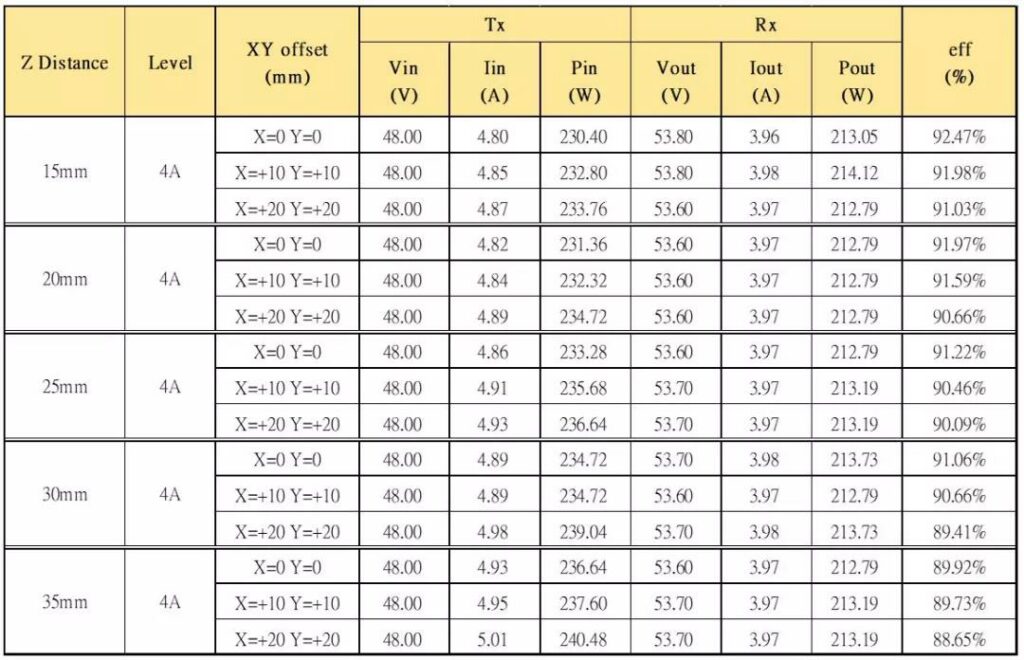
The above is the test data at a distance of 15mm-35mm between coils, with an offset of 10mm and an offset of 20mm. It can be seen from the table that the actual measurement results are very gratifying. The charging distance within 30mm and the offset within 20mm can also achieve a transmission efficiency of 90%, which fully reflects the advantages of wireless charging. It can be charged as soon as it is placed, and it can be used for perfect wireless charging without precise alignment.
200W Industrial Wireless Charging Solution – FOD Test
If there is metal in the wireless charging area, the metal will be heated due to the eddy current effect, which may damage the device or even cause a fire. Metal foreign object detection (FOD) is mainly to prevent metal from being heated in a magnetic field and causing an accident. The power-on FOD and working FOD of the ONE POINTECH 200W wireless charging module are also tested here.
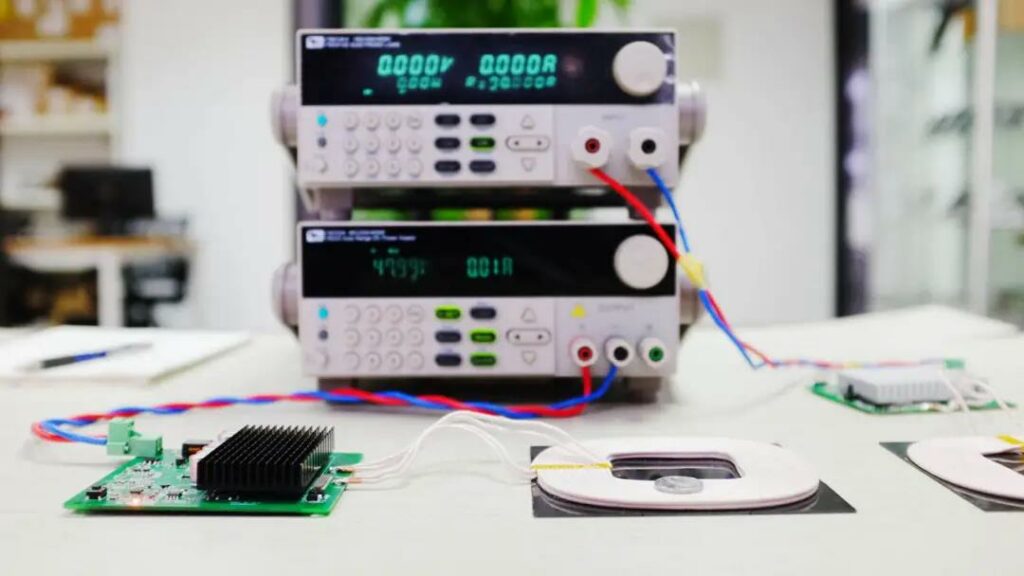
We start by placing a coin on the wireless charging transmitter coil. According to the DC power supply, there is no current output at this time, so we have the result that the transmitter has the metal foreign object detection function in the power-on mode. In practical applications, it will effectively avoid the heating of the external metal by the wireless charging coil.

In addition to foreign object detection in standby mode, we also tested the foreign object detection function of the wireless charging system in working mode. First, separate the transmitter coil and the receiver coil at a distance of 35mm, and connect the DC power supply and electronic load to make it work properly. A coin is then placed between the two coils. After the coin is put in, the entire wireless charging system turns off the power transmission, indicating that metal foreign objects have been detected, and the foreign object detection function is triggered.
At the same time, the FOD function in power-on mode and working mode was also tested when the coil spacing was 15mm, 20mm, 25mm, 30mm, and 35mm. The test results show that it can accurately identify metal foreign objects and automatically stop charging whether it is powered on or in use, thereby ensuring safety.
FOD is one of the protection mechanisms for wireless charging. Excellent FOD can ensure the safety of wireless charging during use. The ONE POINTECH R&D team has made several improvements and optimizations on the FOD algorithm of the wireless charging solution, thus realizing the precise FOD function.
200W Industrial Wireless Charging Solution – Temperature Rise Test
In the temperature rise test, the ambient temperature was 24.9°C, the charging distance was 20mm, and after aging for 1 hour at an output power of 200W, the temperature rise was measured and recorded using a FLUKE VT04A infrared thermal imager.

The test results show that the maximum temperature of the transmitter (Tx) is about 67.9°C, the maximum temperature of the coil is about 42°C, and the maximum temperature of the receiver (Rx) is about 58.3°C.
In addition, at room temperature of 24.9°C, the temperature rise of the transmitter and receiver was tested again with a charging distance of 35mm and output power of 200W for 1 hour of aging.
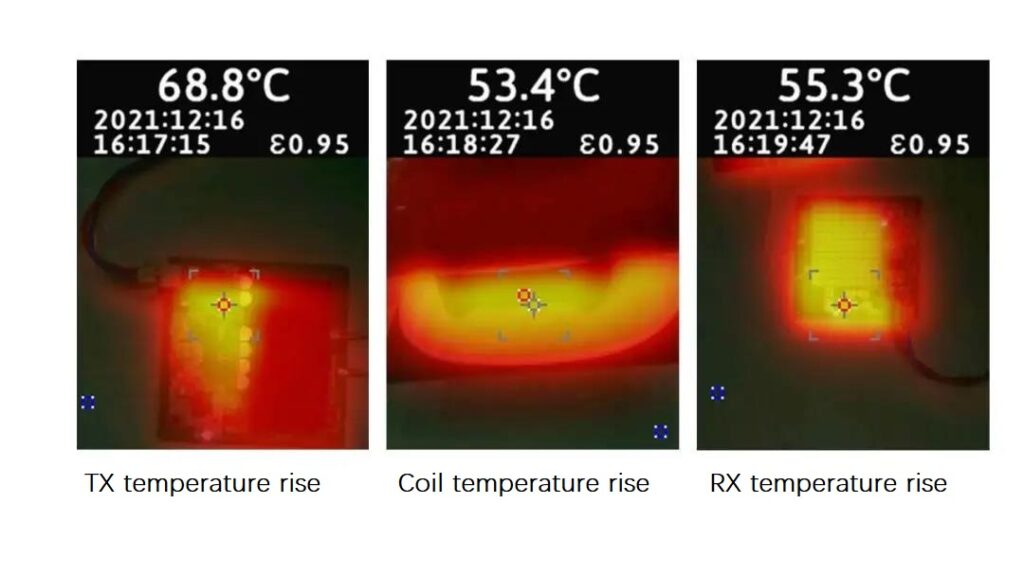
The test results show that the maximum temperature of the transmitter (Tx) is about 68.8°C, the maximum temperature of the coil is about 53.4°C, and the maximum temperature of the receiver (Rx) is about 55.3°C.
From the results, we can see that the 200W wireless charging module optimizes the temperature rise control very well. Coupled with sensitive foreign object detection, stable operation for a long time is not a problem at all. In addition, it also has the characteristics of charging without precise alignment, making the operation easier. These achievements benefit from the joint efforts of ONE POINTECH’s strong R&D team and partners.
Summary
Compared with traditional wired charging, wireless charging has many incomparable advantages, such as non-contact charging, no plugging and unplugging, no electric sparks, and no risk of leakage; no contact, suitable for outdoor, high humidity environments; good reliability, no maintenance, no risk of bad impacts on charging from contact oxidation and contamination; place and charge, easy operation, always keep the devices fully charged.
Compared with traditional wired charging, wireless charging has many incomparable advantages, such as non-contact charging, no plugging and unplugging, no electric sparks, and no risk of leakage; no contact, suitable for outdoor, high humidity and other use environments;
Good reliability, no maintenance, no contact oxidation, and the risk of contamination affecting charging; it can be charged as soon as it is released, and the operation can be worry-free, so that the device will always be fully charged, etc.
Since wireless charging has so many advantages, why is it rarely seen an effective application in daily life? There are two reasons: on the one hand, solution providers are eager to launch semi-mature solutions that fall short of market expectations for various reasons, resulting in a crisis of confidence; on the other hand, the market needs more time to learn, so at to pave the way for future large-area applications.
ONE POINTECH has been investing in research and development in the field of medium-power wireless charging for many years, maintaining strategic cooperative relations with leading application companies in various industries, continuously optimizing system efficiency, transmission distance, stability, and carefully polishing algorithms such as system control and foreign object detection. Not only the transmission efficiency is at the leading level in the industry, but also the functional development of related software ensures stability and security in actual use.
For different application scenarios, the ONE POINTECH 200W wireless charging module can be adjusted to provide customized solutions with different output voltages such as 36V, 24V, and 19V in addition to the current 48V battery charging, which is suitable for more medium-power products. It is because of ONE POINTECH’s control of every detail and joint innovation across knowledge fields that there are medium-power wireless charging products that can be implemented and industrialized today.
In the foreseeable future, medium-power wireless charging and power supply solutions will be widely used in mobile robots, electric bicycles, mobile medical equipment and other application fields.
Feel free to connect with us and discuss our wireless charging solution.

